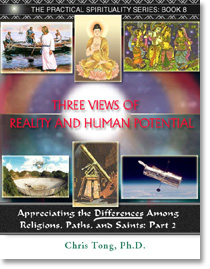1.
Introduction
1.1. Summary
of Part 1: Beyond
Spiritual Correctness
1.1.1. Religious
and spiritual egalitarianism
1.1.2. Religious
and spiritual anti-authoritarianism
1.2. By which
standards should we measure and appreciate differences?
1.3. What sources
should we draw upon?
1.4. Three views
of reality and human potential
1.
Understanding religious and spiritual egalitarianism
1.1. The origins
of egalitarianism
1.2. Egalitarianism
and political correctness as an over-reactive historical phase
1.2.1. Political
correctness as an over-reaction
1.2.2. Political
correctness as a superficial reaction
1.2.3. Political
correctness as an intolerant and unreal philosophy
1.2.4. For
the appreciation of real differences, and against equal
impoverishment
2.
The low view of reality: materialism
2.1. Simple
materialism: the naive realism of sense and “common sense”
2.2. Scientific
materialism: amplifying the senses via technology
2.3. Human potential
within the materialistic view
2.3.1.
Materialistic self-fulfillment
2.3.2.
Materialistic self-transcendence: the attainment of higher, material
purposes
2.3.3.
Materialistic self-improvement
2.4. Limitations
of the materialistic view
2.4.1. The
“obviousness” of naive realism
2.4.2. Scientific
materialism limits itself to the exploration of objective reality
2.4.3. That
which materialism cannot account for is the clue to what will
supercede it
2.4.4. Accounting
for consciousness (and the subjective altogether): the machine
is in the Ghost
2.4.5. Accounting
for human suffering and death; the danger of equating self-fulfillment
with happiness
2.4.6. Free
inquiry vs. the politically and socially enforced reductionism
of scientific materialism
3.
The high view of reality: esoteric spirituality
3.1. The fundamentally
Subjective nature of Reality
3.1.1. The
experience of unity
3.1.2. The
Subjective Substratum in which material reality arises
3.2. Human potential
and the multi-dimensional Greater Reality
3.2.1. Four
distinct views of (and dimensions of) the Greater Reality
3.3. Esoteric
practice, self-transcendence, and Realization of the Greater Reality
3.3.1. Esoteric
Realization and self-transcendence
3.3.2. Self-improvement
vs. self-transcendence
3.3.3. The
need for Greater Help
4.
The exoteric religious view: where esoteric spirituality meets public
opinion
4.1. Elements
of an exoteric view of God and a Greater Reality
4.1.1. View
of reality
4.1.2. Spiritual
mediators
4.1.3. Who
has access to the Greater Reality while still alive
4.1.4. Laws
of moral behavior (that augur a good life and an auspicious after-life
destiny)
4.1.5. Sacred
rituals and ceremonies
4.2. The forces
that shape an exoteric religious belief system
4.2.1. A complex
example in religious evolution: exoteric Christianity and its
sources
4.2.2. The
three primary sources of an exoteric religious tradition
4.2.3. The
origins of exoteric religious beliefs in esoteric egalitarianism
4.2.4. The
neurotic needs of the human ego and their impact on exoteric religion
4.2.5. The
political and social forces that impact an exoteric religious
tradition
4.3. Exoteric
religions that are out of touch with their esoteric roots
4.3.1. The
unfortunate consequences of a divorce between exotericism and
esotericism
4.3.2. The
shortchanging of human potential via an exoteric “easy sell”
(but Spiritually dysfunctional) compromise
4.3.3. The
inherently set-apart Creator God and the passive psychology of
being a “creation”: consolation, dependency, and blame
4.3.4. The
absence of a direct “feedback loop” for gauging Spiritual
Reality and merit
4.3.5. Pharisaism:
valuing “the God of the Book” above Real God
4.3.6. The
exoteric religious taboo against communion (and identity) with
God
4.4. Exoteric
religions that are in touch with their esoteric roots
4.4.1. Exoteric,
belief-based religion as the “outer temple” for esoteric
religion based on spiritual experience
4.4.2. Transforming
the body-mind into a temple: from the subhuman to the human, in
preparation for the spiritual
4.4.3. Freud,
Nietzsche, and Marx never came into contact with legitimate exoteric
religion or genuine esoteric spirituality
5.
The influence of materialism on contemporary exoteric religion and
esoteric spirituality:
the primacy of self over God
5.1. The egocentrization
of exoteric religion
5.2. New Age
“spirituality”: A watered-down, egocentric version of
the esoteric Spiritual
traditions
Conclusion
Preview:
Appreciating
the Differences Among Religions, Paths, and Saints
Part 3: Spiritual Realization and the Ego
BOOK
DESCRIPTION
You may also
be interested
in these related titles:
-
Appreciating the DIFFERENCES Among Religions, Paths, and Saints
|








